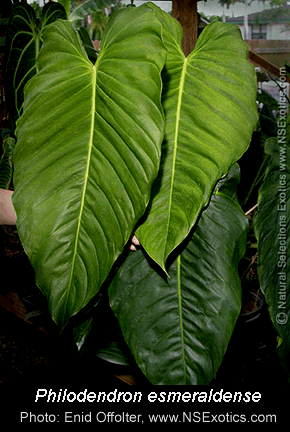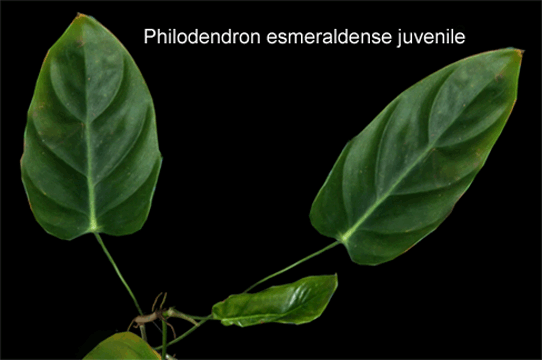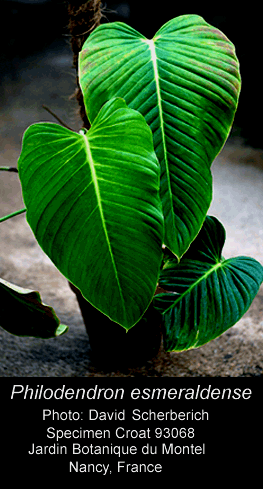![]()
Aroids and other genera in the Collection
Take the Tour Now?
Orchids
The
Exotic Rainforest
Plants in
the Exotic Rainforest Collection
Images on this website are copyright protected. Contact
us before attempting to reuse.
In depth information on how to grow Philodendron species, Click this Link
Within our collection we have many species of Philodendron. If you are seeking other photos, click this link
Philodendron esmeraldense
Croat
This species is yet to be published. As a result, it is not in
italics.

Philodendron esmeraldense Croat
 The species is a
member of a subgenus of section Philodendron but the Philodendron sub-series is yet undetermined. At the
time this page was published (February, 2008) Dr. Croat had yet to make
a final determination. The type specimens were collected along
the road between El Chical and Peņas Blancas on route to Tobar Donoso.
The species is a
member of a subgenus of section Philodendron but the Philodendron sub-series is yet undetermined. At the
time this page was published (February, 2008) Dr. Croat had yet to make
a final determination. The type specimens were collected along
the road between El Chical and Peņas Blancas on route to Tobar Donoso.
Dr. Croat has determined Philodendron
esmeraldense to be both a terrestrial and epiphytic species but the
species has also been observed to be epilithic. The term epiphytic
indicates a species is capable of climbing a host tree and the
scientific term epilithic simply means the species is capable of growing
attached to stone. The leaf blades of P. esmeraldense are narrowly
ovate to sagittate (oval tending towards arrow shaped) and moderately
coriaceous to sub-coriaceous. To a botanist coriaceous indicates the
feel of leather while sub-coriaceous would indicate the feel of very thin
leather. The leaf blades are dark green and possess a less than
velutinous (velvet)
sheen that is slightly matte on the adaxial (upper) surface. The blades also
possess a pale purplish violet tinge on the abaxial surface (underside). A maximum blade
size was not indicated in Dr. Croat's description at this time.
The midrib of the leaf is only slightly raised and very slightly
rounded.
The cataphylls of P. esmeraldense remain
intact after the blade is formed and are a dark reddish brown in color. The cataphylls are the
plant materials that grow around the base of any newly
developing leaf
and measure approximately 30cm (12 inches) in length. Growing as a vine, the internodes of Philodendron
esmeraldense are quite
 short. The petioles measure 23.4 to 73.5cm long
(9.2 to 29 inches) and are terete (cylindrical). The petioles are the
support for each leaf blade.
short. The petioles measure 23.4 to 73.5cm long
(9.2 to 29 inches) and are terete (cylindrical). The petioles are the
support for each leaf blade.
All Philodendron species are aroids. An aroid is a plant that reproduces by producing an inflorescence known to science as a spathe and spadix. Most people believe the spathe is a "flower", it is not. The spathe is simply a specially modified leaf appearing to be a hood whose purpose is to protect the spadix at the center. The spadix is a spike on a thickened fleshy axis which can produce tiny flowers. On the spadix there can be found very tiny flowers when the plant is at anthesis. When ready to reproduce, the spadix produces male, female and sterile flowers which if pollinated by an appropriate insect, normally a beetle, will produce berries containing seeds.
The inflorescence of Philodendron esmeraldense stands erect on a peduncle that measures 62.4 to 113.2cm long (24.5 to 44.5 inches). The inflorescence of any aroid is composed of a spathe and spadix and is often considered a "flower" by collectors. In truth, the spathe is not a flower but is instead a modified leaf blade which shields the spadix at the center of the inflorescence. The true flowers are found on the spadix and are quite small. Those flowers are both male and female and pollination is typically caused by a local insect, often a beetle, that carries pollen from the male flowers of one plant to the female flowers of another. The spathes of P. esmeraldense measure 14.2 to 19.6cm (5.6 to 7.7 inches) in length, and are green at the base blending to white towards the apex but may be purplish with white margins. The color is slightly paler on the inside. The spathe may become darker and purple tinged in the lower one half to one third portion.
Philodendron are known to be highly variable and not every leaf of every specimen will always appear the same. In addition, the blades of Philodendron morph as they grow. This link explains natural variation and morphogenesis within aroids and other species. Click here.
Our specimen was collected in Northern Ecuador near Lita at an elevation of between 600 and 800 meters (roughly 2,000 to 2,600 feet) above sea level. We have the specimen planted in very porous soil that is kept moderately damp. The soil mix is composed of good potting mix, Perlite, peat moss and orchid potting media containing charcoal, bark and gravel. The specimen is allowed to climb a totem and at the present time is still a juvenile growing in bright filtered light.
My sincere thanks to Dr. Croat for providing the scientific information used to create this page. And my additional thanks to both David Scherberich in France as well as Enid Offolter of Natural Selections Exotics in Fort Lauderdale for the use of their photographs. Enid estimates her largest leaf blade to be approximately 76cm (30 inches). The photo by botanist David Scherberich of Philodendron esmeraldense is of specimen Croat 93068 and was photographed at the Jardin Botanique du Montel in Nancy, France.
Specimens may be available
from Natural Selections Exotics
![]()
or Brian's Botanicals
http://www.briansbotanicals.net/

If
you are seeking information on other rare species, click on "Aroids and other genera in the Collection" at the top and look for the
Want to learn more
about aroids?
Join the
International Aroid Society:
http://www.exoticrainforest.com/Join%20IAS.html